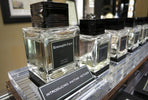
Haitian Vetiver Exports Power Global Luxury Fragrance Market — A Story of Cultural and Economic Pride
, by Seo Guy , 6 min reading time

, by Seo Guy , 6 min reading time
In the lush fields of southwestern Haiti, a fragrant grass called vetiver has been quietly shaping the global perfume industry for decades. Known for its earthy, smoky, and slightly sweet aroma, vetiver is one of the most sought-after ingredients in luxury fragrance formulas. While it grows in several tropical countries, Haitian vetiver is considered the world’s finest, prized for its purity, complexity, and rich olfactory depth.
The Haiti vetiver perfume industry is more than just an agricultural success story—it’s a symbol of cultural pride and economic potential. From small-scale farmers tending their plots to international perfumers crafting high-end scents, the journey of Haitian vetiver reflects resilience, craftsmanship, and the enduring connection between land and livelihood.
Perfumers describe Haitian vetiver as having a cleaner, more refined aroma compared to varieties from other regions. This unique profile makes it a cornerstone in many iconic fragrances by brands like Chanel, Guerlain, and Tom Ford. Its versatility allows it to be used as both a base note and a fixative, meaning it helps other scents last longer on the skin.
For luxury fragrance houses, sourcing from the Haiti vetiver perfume industry is a mark of quality. For Haitian farmers, it’s an opportunity to participate in a global market that values artisanal production and ethical sourcing.
Vetiver farming is labour-intensive, requiring skilled hands to plant, cultivate, and harvest the roots. In rural communities such as Les Cayes and Port-Salut, the industry provides stable income for thousands of families. This stability is especially critical in regions where economic opportunities are limited.
By sustaining employment, the Haiti vetiver perfume industry also supports related sectors such as transportation, processing, and export services. Each shipment of vetiver oil represents not just a commercial transaction, but the livelihoods of entire communities.
The magic of vetiver lies in its roots, which must grow for 12–18 months before harvest. Farmers dig deep to extract the root systems, then wash and dry them before sending them to distilleries. In these facilities, steam distillation transforms the roots into golden-brown essential oil—a process that can take up to 24 hours per batch.
This meticulous process is part science, part tradition. Many distillers inherit their craft from previous generations, ensuring that the production methods remain consistent with Haiti’s reputation for quality. The resulting oil is then packaged for export to fragrance houses around the world.

Vetiver’s benefits go beyond its aromatic properties. The plant has an extensive root system that helps prevent soil erosion, making it a valuable crop for environmental conservation. Its cultivation improves soil stability, supports biodiversity, and reduces the risk of landslides in Haiti’s mountainous terrain.
Some producers in the Haiti vetiver perfume industry are adopting even more sustainable practices, such as organic farming, renewable energy in distillation, and fair-trade certification. These efforts not only protect the environment but also appeal to eco-conscious consumers in the luxury market.
Despite its strengths, the vetiver industry faces challenges. Climate change, inconsistent infrastructure, and fluctuating global demand can affect production and income stability. Additionally, farmers often have limited access to financing and technology that could improve yields and quality control.
International partnerships, training programs, and cooperative models are helping address these issues. By strengthening the value chain from farm to export, stakeholders aim to ensure that the Haiti vetiver perfume industry remains competitive and sustainable.
Vetiver is more than a commodity—it’s part of Haiti’s cultural identity. The earthy scent has long been used in traditional ceremonies, artisanal soaps, and local remedies. In many rural homes, dried vetiver roots are woven into mats or placed in wardrobes as natural air fresheners.
This cultural connection adds another layer of authenticity to Haitian vetiver products. Consumers aren’t just buying an ingredient—they’re buying into a story of heritage, craftsmanship, and pride.
The influence of vetiver extends beyond perfumes. Designers and artisans are incorporating vetiver roots into fashion accessories, home fragrances, and decorative items. Handwoven vetiver mats, baskets, and sachets are popular both locally and internationally, adding a tangible connection to the plant’s natural beauty.
At CreoleSizzle, we celebrate this cultural richness by offering products inspired by vetiver’s earthy tones and textures. Whether in the form of scented candles, art prints, or textiles, these creations bring a piece of Haiti’s natural heritage into homes around the world.
With growing consumer interest in sustainable and ethically sourced ingredients, the outlook for Haitian vetiver is promising. Expanding into niche markets—such as artisanal perfumery, organic personal care, and eco-luxury goods—can help diversify income streams for producers.
Investments in processing facilities, quality certification, and marketing could further elevate the Haiti vetiver perfume industry on the world stage. As awareness grows, so does the potential for vetiver to become not just an export product, but a global ambassador for Haitian excellence.
The story of Haitian vetiver is a story of resilience, artistry, and connection to the land. From rural farmers to master perfumers, countless hands contribute to the journey of this remarkable plant. As the world continues to seek authenticity and sustainability, Haitian vetiver stands ready to deliver both—rooted in tradition, yet reaching toward the future.
Inspired by Haiti’s resilience and vibrancy? ⬇️
Discover art, décor, and fashion that celebrate Haitian culture—visit CreoleSizzle.com and carry culture with pride!